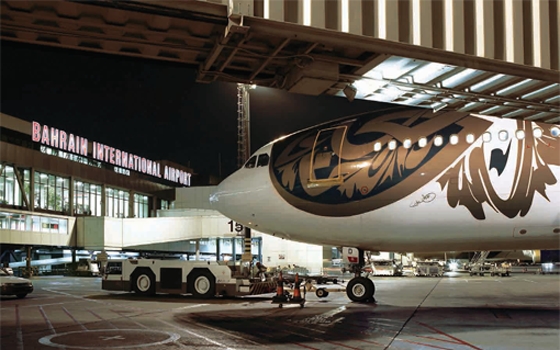With a flurry of new infrastructure projects, the government is selling Bahrain’s regional connectivity as a key attraction for foreign investors. While the island Kingdom may not compete for east-west traffic with global transit centers like Dubai, Doha and Istanbul, Bahrain is carving out a role as a gateway to the GCC markets. As the Gulf countries continue to prioritize the development of non-oil industries, regional trade links are increasingly critical to investment, and a new airport, seaport and rail system are set to provide solid foundations for future growth.
“Optimizing Bahrain’s connectivity to the region through leading facilities plays an important part in our strategy to create sustainable economic growth and high-quality Bahraini jobs for the long term,” Transportation Minister Kamal bin Ahmed told local media in June.
With little land mass and relatively small hydrocarbon resources compared to its neighbors, Bahrain’s competitive advantage lies in easy access to regional markets, especially the giant to the west, Saudi Arabia. Marketing itself as a base from which multinational manufacturers, insurance firms and banks can serve the region, Bahrain saw non-oil GDP rise 6.7% in 2012. At the same time, manufacturing expanded more than 9% and financial services grew 3.5%.
In 2012, FDI Magazine ranked two of Bahrain’s transit centers, the seaport and the airport, among the world’s top 20 special economic zones. Trade links will likely further improve thanks to increased spending on the part of the Bahrain government as well as $10bn in aid that has been committed by the GCC states over a 10-year period, most of which is earmarked for infrastructure development.
“There is sizeable potential to exploit the strategic location of Bahrain as an intermodal freight transportation node,” George Saounatsos, CEO of Bahrain Airport Services, told OBG. “This is mainly due to the direct road network connection to Saudi Arabia, which is the biggest market in the region, the state-of-the-art port and the modern cargo facilities and services provided at the airport along with the warehousing capacity offered,” he said.
Bahrain International Airport, managed by Bahrain Airport Company, ranked 19th on FDI Magazine’s list of global hotspots for investment in 2012. While work on a new airport won’t get under way until 2014 at the earliest, the Ministry of Transportation recently allocated $882m for the expansion and upgrade of the existing facility.
However, not all is booming in Bahrain’s aviation sector, as Gulf Air, the national airline, has lost $5bn since 2009, according to local media, and laid off 770 people in June. While numerous challenges at Gulf Air reflect increased competition in the global aviation sector, the restructuring plans offer insight into Bahrain’s role in the region. The airline is cutting unprofitable long-haul routes to Copenhagen, Rome and Colombo. In their place, Gulf Air will focus on serving as a regional hub, boosting the number of routes to the Middle East and North Africa.
“Gulf Air has been implementing a network and fleet rationalization strategy to become more efficient and competitive,” Saounatsos said. With three international transfer hubs within an hour’s radius (Dubai, Doha and Abu Dhabi), regional carriers have no choice but to adopt a new strategy and redefine their product, he added.
Meanwhile, Bahrain is positioning Khalifa bin Salman Port (KBSP), completed in 2008 and ranked the 16th-best global investment center in 2012, as a key transshipment hub for the northern Gulf. The port hit record throughput volumes in November 2012, and ended the year at half a million twenty-foot equivalent units (TEUs), a 40% increase over 2011. Transshipment volumes were the leading contributor to growth, increasing 149% compared with a year earlier.
Yet these figures are relatively small compared to those from other ports in the Gulf, including Oman’s Salalah, which handled 3.2m TEUs last year, or Abu Dhabi’s Khalifa port, which opened in 2012 with an annual capacity of 2.2m TEUs, not to mention global giants like Dubai’s Jebel Ali, with a throughput of 13m TEUs last year. Despite this, KBSP remains the largest port in the northern Gulf, and the harbor can successfully serve as a hub for smaller vessels to link to ports in Iraq, eastern Saudi Arabia and Kuwait. Indeed, the United Arab Shipping Company, owned by a consortium of GCC countries, is adding routes between KBSP and Sohar, Jeddah and Jubail.
To ease overwhelming congestion on the Saudi Arabia-Bahrain causeway and expand regional linkages, Bahrain is investing in multi-billion-dollar rail projects. A new railway will connect the Kingdom to the 2000-km pan-GCC network scheduled for completion in 2018. Rail links from the island to both Saudi Arabia and Qatar are planned, with the former to run parallel to the causeway. Both public and private sector sources are expected to finance these projects.
Perhaps as an indication of how crucial transport is to Bahrain’s economic future, Transportation Minister Ahmed was appointed acting CEO of the Economic Development Board last year. Regarding his work at the transportation ministry, he said the recent planned upgrades will enable the sector to “compete more effectively on a global level. This, of course, would ultimately be a benefit for the economy of the Kingdom as a whole”.
Oxford Business Group
30 July






















































